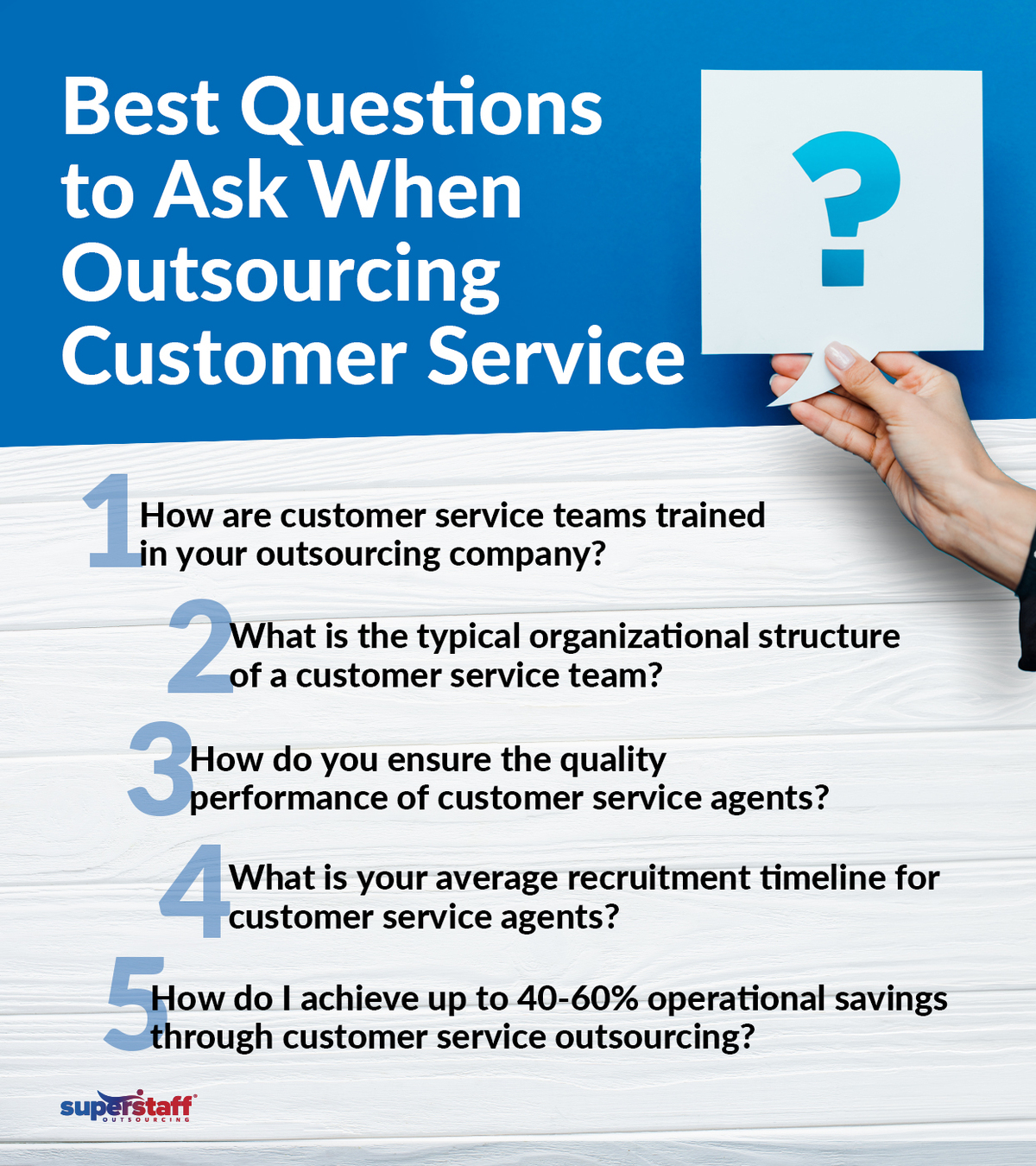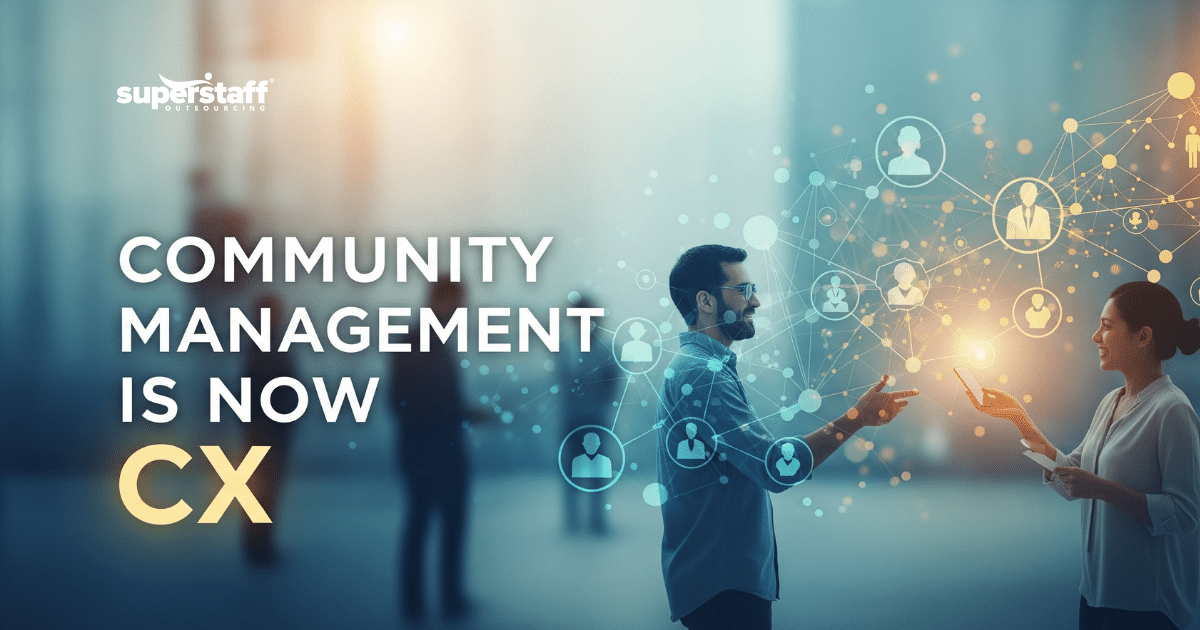
Are you seeking ways to meet customers’ needs and expectations without incurring the high costs of additional departments? Customer service outsourcing may be the solution you need.
In a highly competitive market, superior customer service distinguishes your brand and encourages customer loyalty. It can give your business a competitive edge, resulting in referrals, strong customer relationships, and cost-effective investments.
This article explores the best questions to ask to understand the customer service outsourcing process better.
Best Questions to Ask When Outsourcing Customer Service

What are the ultimate benefits of customer service outsourcing?
- Cost Savings: Eliminates the need for investing in infrastructure, technology, and extensive in-house teams, leading to significant cost savings.
- Access to Expertise and Advanced Technology: Provides access to the latest technologies, including AI, automation, and advanced CRM systems, which might be cost-prohibitive for individual companies to implement.
- Scalability and Flexibility: Scales operations up or down based on demand, allowing businesses to handle seasonal spikes and unexpected surges in call volumes
- Focus on Core Competencies: Empowers businesses to concentrate on their core business activities, such as product development, marketing, and sales, while leaving customer support to specialists.
- Improved Customer Experience: Round-the-clock customer service, ensuring customers receive support whenever needed.
- Omnichannel Support: Integrated support across various channels (phone, email, chat, social media), providing a seamless and consistent customer experience.
- Personalization: Personalized and tailored customer interactions, enhancing satisfaction and loyalty.
- Operational Efficiency: Best practices and streamlined processes to handle customer inquiries efficiently, reducing response times and increasing resolution rates.
- Data Analytics: Advanced analytics and AI for proactive support — addressing issues before they escalate
- Risk Management: Robust security measures and compliance with regulations (e.g., GDPR, CCPA), reducing the risk of data breaches and legal issues. Contingency plans and disaster recovery protocols are in place, ensuring uninterrupted service during crises.
- Access to a Global Talent Pool: Recruits talent from various regions for a diverse and multilingual workforce catering to a global customer base.
- Better Employee Retention: Reduces the high turnover rates standard in customer service roles.
How are customer service teams trained in outsourcing companies?
Trainer-led
- The trainer receives training from the client’s trainers and gets certified to train agents.
- The trainer will then conduct the training for the agents.
Trainer Sit-in
- The trainer receives training together with the first batch of agents
- The trainer will then conduct the training for the next batch of agents
Immersive Training
- Client trains agents exclusively.
- Recommended for accounts involving government contracts where classified information is involved
- Best-suited for team set-up where some team members are not directly involved with the client
Self-paced Training
- Client provides knowledge-based content or online course
- A trainer supervises the training to ensure agents understand the client’s operational needs
What is the typical organizational structure of a customer service team in outsourcing companies?
A standard organizational structure of a customer service team usually consists of the following:
- Country Manager – Country managers are responsible for the country’s overall operations and business development
- Director of Operations – These directors oversee the contact center and customer service center operations and their performance.
- Program Manager – Program managers handle the development of programs and strategies, ensuring the success of said programs by aligning the strategy’s goals with it
- Team Leader – Team leaders handle and supervise the team of agents, agents of customer service, technical support, and specialists. Each team leader handles a team of 5-15 agents.
- Customer Service or Technical Support Agents – Those in direct contact with customer inquiries and needs, attend to customer inquiries via different channels.
Why should you outsource in the Philippines?
Globally recognized as The Call Center Capital of the World, the Philippines lives up to this reputation thanks to its cost-efficient yet highly efficient services. A strong factor contributing to this recognition is the Filipino workforce.

What is the average recruitment timeline for customer service agents in the United States vs. the Philippines?
The average recruitment timeline for customer service agents can vary between the U.S. and the Philippines. In the U.S., the process typically ranges from 4 to 6 weeks and involves job posting, screening, interviews, and onboarding. In the Philippines, it generally takes 2 to 4 weeks due to a larger pool of readily available candidates and streamlined hiring processes.
How do companies achieve up to 40-60% operational savings through customer service outsourcing?
The cost of living in the Philippines is considerably lower than in countries like the U.S. or Europe, translating into lower employee wages, which doesn’t necessarily equate to a lower standard of living for them.
Wages considered modest by Western standards can offer a comfortable lifestyle in the Philippines. The country’s economic advantage enables companies to pay their employees competitive wages locally, which are substantially lower than what they would pay in their home countries for the same level of skill and expertise.
When comparing average monthly net salaries (after tax) across different countries, the Philippines stands out with significantly lower figures than countries like the U.S., Australia, and the U.K. In the Philippines, the average monthly net salary amounts to $366.83. In contrast, in the U.S., the average is $4,539.44; in Australia, it is $3,777.28; and in the United Kingdom, it is $3,063.69. These disparities reflect varying economic conditions and cost of living factors between these nations, influencing respective living standards.
How can you build a successful customer service outsourcing team in the Philippines?
Building a successful customer service outsourcing team in the Philippines can be done in 5 steps:
- Identify your needs — Understanding what you need to address, such as gaps and pain points, is essential. Identify these data as precisely as possible and involve key stakeholders in this process. After assessing these, develop a project plan that includes a baseline project scope, project goals, budget, timeline, and required tasks.
- Identify your service provider — Understanding the outsourcing company that will provide its services for you is the next important step in understanding its capabilities and what it can offer your business. One of the critical details to know is who the company is, the types of services it provides, who its target audiences are and who receives its services, what makes it stand out, and what its advantages are.
- Begin sending your document of requests – As you identify your needs and potential providers, this process involves sending documents such as the Request for Information (RFI), Request for Quotes (RFQ), and Request for Proposal (RFP). The RFI is the document used to request information such as their capabilities and provisions they can offer. The RFQ is used to request the company’s quotations, to assess if your company is within your budget capabilities. The RFP is the document to outlines specific services and products that your business needs; typically, it’s to help you decide which of your shortlisted companies you would like to choose.
- Negotiate your partnership terms and contract —This step involves negotiating and communicating your partnership terms with your outsourcing company. Once you and your outsourcing partner agree on those terms, you will sign a Master Services Agreement (MSA) or a Service Level Agreement (SLA).
- Set your Key Performance Indicators (KPIs) — Once you’ve both signed your terms and contract, it’s essential to set your KPIs to assess whether your signed partner meets your company’s needs and goals.
Do Filipino agents undergo English proficiency training?
While the Filipino workforce and agents are proficient in English, Filipino agents still undergo training to ensure consistency, proper communication, and excellent service when engaging with customers globally. The English proficiency training typically covers grammar rules, adequate diction/pronunciation, conversational English, and common idioms. This training is especially essential for agents who interact often with customers from the United States.
What other training do they undergo?
Agents’ training typically includes communication, culture, customer handling, account-specific training, and tool usage.
- Communication Training — Communication training is still essential in ensuring smooth and efficient English communication between agents and clients, especially clients from the US.
- Culture Training — Cultural awareness for the agents is critical, given that clients or customers come from different cultural backgrounds. Trainees must undergo this training to achieve cultural sensitivity and an understanding of etiquette.
- Customer Handling — In customer service, agents may often encounter demanding customers. This training is essential to teach an agent what to do during these difficult situations. Customer handling training usually gives the trainees firsthand experience, such as practice training or calls.
- Account-Specific Training — Customer agents represent their company and the tools and services they provide. The trainee must undergo this training to understand their company and services entirely.
- Tools Usage — Agents use different tools to communicate effectively with customers. This training gives them hands-on experience with tools for creating tickets, navigating accounts and history, transferring calls, and more.
How do Philippine BPOs ensure the quality performance of customer service agents?
Key Performance Indicators, or KPIs, are used to ensure the quality of the agents’ performances. KPIs ensure the agents meet the standards and goals of what the company desires to achieve. Below are a list of common KPIs used in the BPO space:
- Customer Satisfaction – These are the feedbacks that customers have for you and your service
- Average Handle Time – This indicates how long customers wait in line or queue before reaching an agent.
- First Call Resolution—This indicates if the customer’s first call to the agent resolved their immediate concern, measured by how many times the customer calls back regarding the same problem.
- Average Resolution Time – Indicates how long it takes to resolve customer concerns.
- Customer Churn – Indicates customers who continue to choose your brand or business.
- Repeated Contact Rate – Indicates the number of times of a previously raised concern.
- Abandon Rate – Indicates how often a customer leaves without a response or a resolution from the service.
State of Customer Care in 2024
Significant challenges and opportunities shape today’s customer care. Leaders like you must navigate the talent shortage, manage increasing call volumes, meet evolving customer expectations, and leverage digital and AI technologies while ensuring a seamless omnichannel experience.
Let’s dissect these challenges and learn how they can impact your business.
Persistent Talent Shortage
The high-pressure nature of customer service roles makes employees particularly vulnerable to burnout, resulting in higher churn rates. Additionally, the shift to digital and AI-driven solutions demands new skills that many current employees lack. Therefore, attracting and retaining skilled customer care representatives has become increasingly difficult.
Increase in Call Volume
Even with automated digital channels growing unprecedentedly, call volumes continue to soar simultaneously. Humans still prefer to speak to live representatives, especially for urgent or sensitive issues. Still, customers often turn to phone support for complex problems that automated or digital channels cannot resolve. The integration of various channels means customers may start with digital channels but escalate to phone support.
Rapidly Changing Customer Expectations
Gone are the days when customers simply wanted their calls answered. Nowadays, your customers demand:
- Personalized interactions and solutions tailored to their specific needs.
- Quick and efficient service; minimal wait times and fast resolutions
- Seamless, round-the-clock, omnichannel support
Despite the rapidly evolving customer care landscape, the good news is that the customer service industry is well-positioned to keep pace with the digital age. Companies can effectively meet customer expectations by leveraging advanced technologies and innovative approaches.
AI+Human Customer Support
As the AI revolution enters customer service, it brings advantages and challenges. The technology powers efficiency by automating mundane tasks that could otherwise burden customer service agents.
How does AI help shape the customer service landscape?
- AI Chatbots and Virtual Assistants handle many customer queries, offering quick and accurate responses.
- Predictive Analytics anticipates customer needs and issues before they arise, improving proactive support.
- Self-service portals allow customers to find answers and resolve problems independently.
Still, with all AI’s contributions, customers seek human interaction, as genuine and meaningful connections are something AI can never replace.
Almost half (47.2%) of boomers demand that humans still oversee AI interventions. Thirty percent of Gen-Zs, 29.5% of millennials, and 35.8% of the Gen-X demographic also share this sentiment, reflecting the overwhelming number of people who still prefer communicating with a human. This preference is evident across different industries, especially in the banking and financial services, healthcare, online retail, and telecom industries.
Omnichannel Solutions
Visiting the stores is still vital to the customer shopping experience, as it offers an immersive experience that digital stores cannot replicate. Businesses are turning to a hybrid approach that combines the advantages of physical and online shopping, known as phygital shopping, to bridge the gap. The key to making the transition as smooth as possible is omnichannel solutions.
From online orders and store visits to phone inquiries and emails, here’s how you can create a seamless customer journey with omnichannel solutions:
- Various communication channels (e.g., phone, email, chat, social media) into a single system
- Consistent experience across all channels, with their information and history readily accessible regardless of the platform they use.
- Advanced analytics track customer interactions across channels, providing insights to improve service and personalize interactions.
Data Analytics and Personalization
It’s no secret that customer expectations have been higher than ever. With that in mind, customer service analytics has become essential for improving customer satisfaction and boosting your brand.
But what is it exactly? Customer service analytics is the process of analyzing data arising from service interactions. There are different types of customer service analytics, including data involving previous customer interactions, the outcomes from specific customer service, and predictive analytics with the help of AI.
According to one report, 96% of service leaders value trustworthy data, but only about 44% rely on data when making decisions. As more leaders realize the importance of data for business growth, this trend may grow further according to expectations.
Remote and Hybrid Workforce
The current shortage of customer service representatives and the rising preference for hybrid and work-from-home arrangements are intricately linked. As the demand for flexible working conditions increases, many skilled professionals opt for roles that allow them to balance their professional and personal lives more effectively.
This shift has made traditional in-office customer service positions less attractive, contributing to the talent shortage in this sector. Companies that adapt by offering remote or hybrid work options are more likely to attract and retain top talent, ensuring their customer service teams remain robust and effective. Embracing these modern work preferences addresses the staffing challenge and enhances overall employee satisfaction and productivity.
In connection with this, wages for customer service representatives have not kept pace with the rising cost of living in many parts of the U.S. This wage stagnation makes these positions less attractive, leading potential workers to seek better-paying opportunities. High turnover rates in the industry reflect dissatisfaction with job conditions, leading to fewer individuals pursuing or remaining in these roles.
Customer Service Outsourcing With the Right Partner
As customer demands grow more sophisticated, customer service outsourcing remains a steadfast solution to meet your company’s evolving needs. SuperStaff offers over a decade of expertise in outsourcing, ensuring your customer service requirements are met effectively.
Contact us today to learn how we can support your customer service outsourcing needs!






